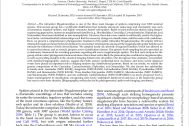Year
2020Content
The infraorder Mygalomorphae is one of the three main lineages of spiders comprising over 3000 nominal species. This ancient group has a worldwide distribution that includes among its ranks large and charismatic taxa such as tarantulas, trapdoor spiders, and highly venomous funnel-web spiders. Based on past molecular studies using Sanger-sequencing approaches, numerous mygalomorph families (e.g., Hexathelidae, Ctenizidae, Cyrtaucheniidae, Dipluridae, and Nemesiidae) have been identified as non-monophyletic. However, these data were unable to sufficiently resolve the higher-level (intra- and interfamilial) relationships such that the necessary changes in classification could be made with confidence. Here, we present a comprehensive phylogenomic treatment of the spider infraorder Mygalomorphae. We employ 472 loci obtained through anchored hybrid enrichment to reconstruct relationships among all the mygalomorph spider families and estimate the timeframe of their diversification. We sampled nearly all currently recognized families, which has allowed us to assess their status, and as a result, propose a new classification scheme. Our generic-level sampling has also provided an evolutionary framework for revisiting questions regarding silk use in mygalomorph spiders. The first such analysis for the group within a strict phylogenetic framework shows that a sheet web is likely the plesiomorphic condition for mygalomorphs, as well as providing insights to the ancestral foraging behavior for all spiders. Our divergence time estimates, concomitant with detailed biogeographic analysis, suggest that both ancient continental-level vicariance and more recent dispersal events have played an important role in shaping modern day distributional patterns. Based on our results, we relimit the generic composition of the Ctenizidae, Cyrtaucheniidae, Dipluridae, and Nemesiidae. We also elevate five subfamilies to family rank: Anamidae (NEW RANK), Euagridae (NEW RANK), Ischnothelidae (NEW RANK), Pycnothelidae (NEW RANK), and Bemmeridae (NEW RANK). Three families Entypesidae (NEW FAMILY), Microhexuridae (NEW FAMILY), and Stasimopidae (NEW FAMILY), and one subfamily Australothelinae (NEW SUBFAMILY) are newly proposed. Such a major rearrangement in classification, recognizing nine newly established family-level rank taxa, is the largest the group has seen in over three decades.



